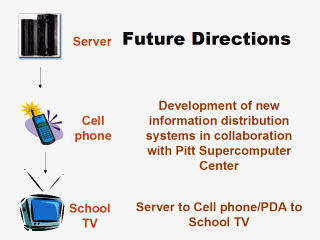| front |1 |2 |3 |4 |5 |6 |7 |8 |9 |10 |11 |12 |13 |14 |15 |16 |17 |18 |19 |20 |21 |22 |23 |24 |25 |26 |27 |28 |review |
 |
As we pointed out
earlier, not all teachers are connected to computers, however many people
own cell phones and many schools (even in the developing world) have at
least one TV. We need to harness the newest technology to deliver prevention
to remote regions.
Modern cell phones and PDAs have larger memory storage capacities. Modern cell phones have at least 2 MB of storage and PDA average at about 16 MBs. With the Supercourse lectures being 300 KB each, downloading at least 6 of them into a memory of a cell phone should not be a problem. TV would be a presentation media for a lecture downloaded to a cell phone. Steps of how the system would work:
To use this simple model all a village needs is a cell phone, and at TV |